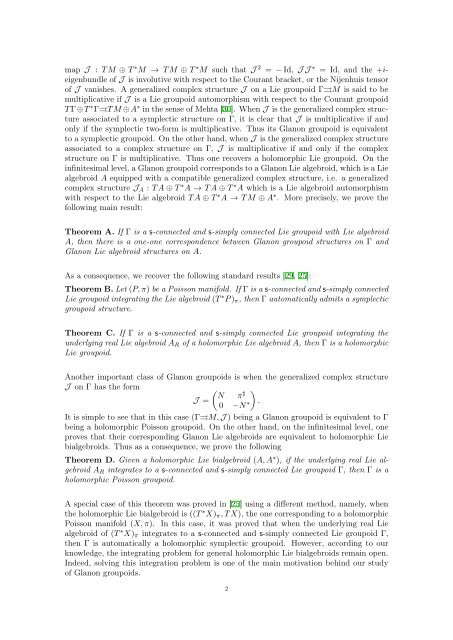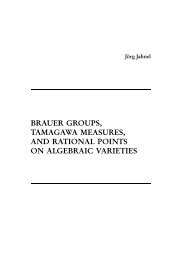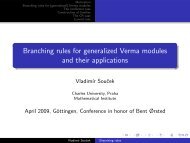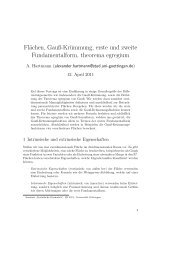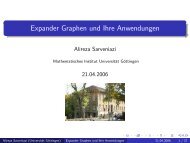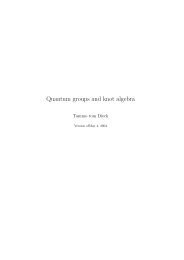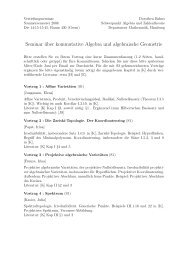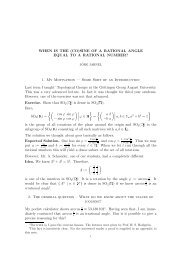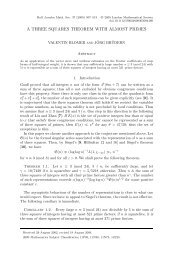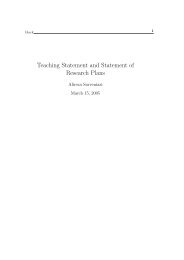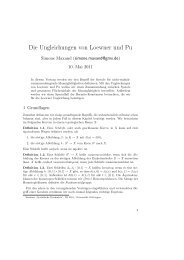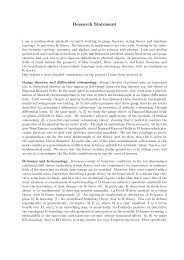Glanon groupoids - Mathematisches Institut - GWDG
Glanon groupoids - Mathematisches Institut - GWDG
Glanon groupoids - Mathematisches Institut - GWDG
Create successful ePaper yourself
Turn your PDF publications into a flip-book with our unique Google optimized e-Paper software.
map J : T M ⊕ T ∗ M → T M ⊕ T ∗ M such that J 2 = − Id, J J ∗ = Id, and the +ieigenbundle<br />
of J is involutive with respect to the Courant bracket, or the Nijenhuis tensor<br />
of J vanishes. A generalized complex structure J on a Lie groupoid Γ⇒M is said to be<br />
multiplicative if J is a Lie groupoid automorphism with respect to the Courant groupoid<br />
T Γ⊕T ∗ Γ⇒T M ⊕A ∗ in the sense of Mehta [30]. When J is the generalized complex structure<br />
associated to a symplectic structure on Γ, it is clear that J is multiplicative if and<br />
only if the symplectic two-form is multiplicative. Thus its <strong>Glanon</strong> groupoid is equivalent<br />
to a symplectic groupoid. On the other hand, when J is the generalized complex structure<br />
associated to a complex structure on Γ, J is multiplicative if and only if the complex<br />
structure on Γ is multiplicative. Thus one recovers a holomorphic Lie groupoid. On the<br />
infinitesimal level, a <strong>Glanon</strong> groupoid corresponds to a <strong>Glanon</strong> Lie algebroid, which is a Lie<br />
algebroid A equipped with a compatible generalized complex structure, i.e. a generalized<br />
complex structure J A : T A ⊕ T ∗ A → T A ⊕ T ∗ A which is a Lie algebroid automorphism<br />
with respect to the Lie algebroid T A ⊕ T ∗ A → T M ⊕ A ∗ . More precisely, we prove the<br />
following main result:<br />
Theorem A. If Γ is a s-connected and s-simply connected Lie groupoid with Lie algebroid<br />
A, then there is a one-one correspondence between <strong>Glanon</strong> groupoid structures on Γ and<br />
<strong>Glanon</strong> Lie algebroid structures on A.<br />
As a consequence, we recover the following standard results [29, 25]:<br />
Theorem B. Let (P, π) be a Poisson manifold. If Γ is a s-connected and s-simply connected<br />
Lie groupoid integrating the Lie algebroid (T ∗ P ) π , then Γ automatically admits a symplectic<br />
groupoid structure.<br />
Theorem C. If Γ is a s-connected and s-simply connected Lie groupoid integrating the<br />
underlying real Lie algebroid A R of a holomorphic Lie algebroid A, then Γ is a holomorphic<br />
Lie groupoid.<br />
Another important class of <strong>Glanon</strong> <strong>groupoids</strong> is when the generalized complex structure<br />
J on Γ has the form<br />
( )<br />
N π<br />
♯<br />
J =<br />
0 −N ∗ .<br />
It is simple to see that in this case (Γ⇒M, J ) being a <strong>Glanon</strong> groupoid is equivalent to Γ<br />
being a holomorphic Poisson groupoid. On the other hand, on the infinitesimal level, one<br />
proves that their corresponding <strong>Glanon</strong> Lie algebroids are equivalent to holomorphic Lie<br />
bialgebroids. Thus as a consequence, we prove the following<br />
Theorem D. Given a holomorphic Lie bialgebroid (A, A ∗ ), if the underlying real Lie algebroid<br />
A R integrates to a s-connected and s-simply connected Lie groupoid Γ, then Γ is a<br />
holomorphic Poisson groupoid.<br />
A special case of this theorem was proved in [25] using a different method, namely, when<br />
the holomorphic Lie bialgebroid is ((T ∗ X) π , T X), the one corresponding to a holomorphic<br />
Poisson manifold (X, π). In this case, it was proved that when the underlying real Lie<br />
algebroid of (T ∗ X) π integrates to a s-connected and s-simply connected Lie groupoid Γ,<br />
then Γ is automatically a holomorphic symplectic groupoid. However, according to our<br />
knowledge, the integrating problem for general holomorphic Lie bialgebroids remain open.<br />
Indeed, solving this integration problem is one of the main motivation behind our study<br />
of <strong>Glanon</strong> <strong>groupoids</strong>.<br />
2


